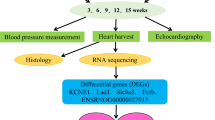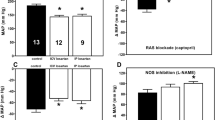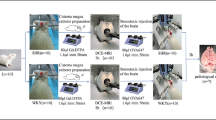Abstract
We evaluated the effects of the angiotensin II (Ang II) receptor blocker (ARB) losartan on the formation and number of endothelial progenitor cells (EPCs) in hypertensive rats. Wistar-Kyoto (WKY) rats and stroke-prone, spontaneously hypertensive rats (SHR-SP) were salt-loaded and then treated with losartan (10 mg/kg/day), trichlormethiazide (TCM; 1.6 mg/kg/day), or tempol (1 mmol/L) for 2 weeks. Peripheral blood mononuclear cells were isolated, subjected to flow cytometric analysis to determine the number of circulating EPCs, cultured to assay EPC colony formation, and subjected to a migration chamber assay to evaluate EPC migration. Oxidative stress in EPCs was evaluated by thiobarbituric acid reactive substance (TBARS) assay. The results showed that the number, colony formation, and migration of EPCs were markedly decreased in SHR-SP compared to those in WKY rats. The TBARS scores were significantly greater in SHR-SP than in WKY rats. Losartan and TCM decreased systolic blood pressure in SHR-SP to similar levels. Losartan and tempol increased the number of circulating EPCs and colony formation, and inhibited oxidation in SHR-SP. TCM did not affect the EPC number, colony formation, or oxidation. Both losartan and TCM stimulated EPC migration. Expression of gp91phox, p22phox, and p47phox mRNA in tissues was significantly decreased by losartan but not by TCM. These results indicate that the formation and function of EPCs are impaired by oxidative stress in SHR-SP. This is the first report to show that losartan improves the proliferation and function of EPCs in hypertension, suggesting that ARBs are useful to repair hypertensive vascular injuries.
Similar content being viewed by others
Article PDF
References
Li PG, Xu JW, Ikeda K, et al: Caffeic acid inhibits vascular smooth muscle cell proliferation induced by angiotensin II in stroke-prone spontaneously hypertensive rats. Hypertens Res 2005; 28: 369–377.
Brassard P, Amiri F, Schiffrin EL : Combined angiotensin II type 1 and type 2 receptor blockade on vascular remodeling and matrix metalloproteinases in resistance arteries. Hypertension 2005; 46: 598–606.
Toba H, Shimizu T, Miki S, et al: Calcium channel blockers reduce angiotensin II–induced superoxide generation and inhibit lectin-like oxidized low-density lipoprotein receptor-1 expression in endothelial cells. Hypertens Res 2006; 29: 105–116.
Touyz RM : Reactive oxygen species, vascular oxidative stress, and redox signaling in hypertension: what is the clinical significance? Hypertension 2004; 44: 248–252.
Asahara T, Murohara T, Sullivan A, et al: Isolation of putative progenitor endothelial cells for angiogenesis. Science 1997; 275: 964–967.
Shi Q, Rafii S, Wu MH, et al: Evidence for circulating bone marrow–derived endothelial cells. Blood 1998; 92: 362–367.
Folkman J : Angiogenesis in cancer, vascular, rheumatoid and other disease. Nat Med 1995; 1: 27–31.
Takahashi T, Kalka C, Masuda H, et al: Ischemia- and cytokine-induced mobilization of bone marrow–derived endothelial progenitor cells for neovascularization. Nat Med 1999; 5: 434–438.
Asahara T, Masuda H, Takahashi T, et al: Bone marrow origin of endothelial progenitor cells responsible for postnatal vasculogenesis in physiological and pathological neovascularization. Circ Res 1999; 85: 221–228.
Hill JM, Zalos G, Halcox JP, et al: Circulating endothelial progenitor cells, vascular function, and cardiovascular risk. N Engl J Med 2003; 348: 593–600.
Vasa M, Fichtlscherer S, Aicher A, et al: Number and migratory activity of circulating endothelial progenitor cells inversely correlate with risk factors for coronary artery disease. Circ Res 2001; 89: E1–E7.
Choi JH, Kim KL, Huh W, et al: Decreased number and impaired angiogenic function of endothelial progenitor cells in patients with chronic renal failure. Arterioscler Thromb Vasc Biol 2004; 24: 1246–1252.
Eizawa T, Ikeda U, Murakami Y, et al: Decrease in circulating endothelial progenitor cells in patients with stable coronary artery disease. Heart 2004; 90: 685–686.
Heeschen C, Lehmann R, Honold J, et al: Profoundly reduced neovascularization capacity of bone marrow mononuclear cells derived from patients with chronic ischemic heart disease. Circulation 2004; 109: 1615–1622.
Grisar J, Aletaha D, Steiner CW, et al: Depletion of endothelial progenitor cells in the peripheral blood of patients with rheumatoid arthritis. Circulation 2005; 111: 204–211.
Balin AK, Fisher AJ, Anzelone M, Leong I, Allen RG : Effects of establishing cell cultures and cell culture conditions on the proliferative life span of human fibroblasts isolated from different tissues and donors of different ages. Exp Cell Res 2002; 274: 275–287.
Walter DH, Rittig K, Bahlmann FH, et al: Statin therapy accelerates reendothelialization: a novel effect involving mobilization and incorporation of bone marrow–derived endothelial progenitor cells. Circulation 2002; 105: 3017–3024.
Shintani S, Murohara T, Ikeda H, et al: Mobilization of endothelial progenitor cells in patients with acute myocardial infarction. Circulation 2001; 103: 2776–2779.
Morii T, Nishikawa K, Shimoyama T, et al: Quantitative flow-cytometric analysis of CD34-positive stem cells in peripheral blood stem cell harvests. Jpn J Clin Hematol 1994; 35: 649–656.
Yamaguchi J, Kusano KF, Masuo O, et al: Stromal cell–derived factor-1 effects on ex vivo expanded endothelial progenitor cell recruitment for ischemic neovascularization. Circulation 2003; 107: 1322–1328.
Asahara T, Takahashi T, Masuda H, et al: VEGF contributes to postnatal neovascularization by mobilizing bone marrow–derived endothelial progenitor cells. EMBO J 1999; 18: 3964–3972.
Kitiyakara C, Chabrashvili T, Chen Y, et al: Salt intake, oxidative stress, and renal expression of NAD(P)H oxidase and superoxide dismutase. J Am Soc Nephrol 2003; 14: 2775–2782.
Tahira Y, Fukuda N, Endo M, et al: Transforming growth factor-beta expression in cardiovascular organs in stroke-prone spontaneously hypertensive rats with the development of hypertension. Hypertens Res 2002; 25: 911–918.
Winer J, Jung CK, Shackel I, Williams PM : Development and validation of real-time quantitative reverse transcriptase–polymerase chain reaction for monitoring gene expression in cardiac myocytes in vitro. Anal Biochem 1999; 270: 41–49.
Moriki N, Ito M, Seko T, et al: RhoA activation in vascular smooth muscle cells from stroke-prone spontaneously hypertensive rats. Hypertens Res 2004; 27: 263–270.
Negishi H, Ikeda K, Sagara M, Sawamura M, Yamori Y : Increased oxidative DNA damage in stroke-prone spontaneously hypertensive rats. Clin Exp Pharmacol Physiol 1999; 26: 482–484.
Lee MC, Shoji H, Miyazaki H, et al: Assessment of oxidative stress in the spontaneously hypertensive rat brain using electron spin resonance (ESR) imaging and in vivo L-band ESR. Hypertens Res 2004; 27: 485–492.
Rajagopalan S, Kurz S, Munzel T, et al: Angiotensin II–mediated hypertension in the rat increases vascular superoxide production via membrane NADH/NAD(P)H oxidase activation. Contribution to alterations of vasomotor tone. J Clin Invest 1996; 97: 1916–1923.
Lassegue B, Clempus RE : Vascular NAD(P)H oxidases: specific features, expression, and regulation. Am J Physiol Regul Integr Comp Physiol 2003; 285: R277–R297.
Griendling KK, Sorescu D, Ushio-Fukai M : NAD(P)H oxidase: role in cardiovascular biology and disease. Circ Res 2000; 86: 494–501.
Taniyama Y, Griendling KK : Reactive oxygen species in the vasculature: molecular and cellular mechanisms. Hypertension 2003; 42: 1075–1081.
Hamilton CA, Miller WH, Al-Benna S, et al: Strategies to reduce oxidative stress in cardiovascular disease. Clin Sci (Lond) 2004; 106: 219–234.
Imanishi T, Moriwaki C, Hano T, Nishio I : Endothelial progenitor cell senescence is accelerated in both experimental hypertensive rats and patients with essential hypertension. J Hypertens 2005; 23: 1831–1837.
Imanishi T, Hano T, Nishio I : Angiotensin II accelerates endothelial progenitor cell senescence through induction of oxidative stress. J Hypertens 2005; 23: 97–104.
Britten MB, Abolmaali ND, Assmus B, et al: Infarct remodeling after intracoronary progenitor cell treatment in patients with acute myocardial infarction (TOPCARE-AMI): mechanistic insights from serial contrast-enhanced magnetic resonance imaging. Circulation 2003; 108: 2212–2218.
Imanishi T, Hano T, Sawamura T, Nishio I : Oxidized low-density lipoprotein induces endothelial progenitor cell senescence, leading to cellular dysfunction. Clin Exp Pharmacol Physiol 2004; 31: 407–413.
Dernbach E, Urbich C, Brandes RP, Hofmann WK, Zeiher AM, Dimmeler S : Antioxidative stress–associated genes in circulating progenitor cells: evidence for enhanced resistance against oxidative stress. Blood 2004; 104: 3591–3597.
Ivanova NB, Dimos JT, Schaniel C, Hackney JA, Moore KA, Lemischka IR : A stem cell molecular signature. Science 2002; 298: 601–604.
Ramalho-Santos M, Yoon S, Matsuzaki Y, Mulligan RC, Melton DA : “Stemness”: transcriptional profiling of embryonic and adult stem cells. Science 2002; 298: 597–600.
Noble M, Smith J, Power J, Mayer-Proschel M : Redox state as a central modulator of precursor cell function. Ann N Y Acad Sci 2003; 991: 251–271.
Kobayashi K, Imanishi T, Akasaka T : Endothelial progenitor cell differentiation and senescence in an angiotensin II–infusion rat model. Hypertens Res 2006; 29: 449–455.
Serrano AL, Andres V : Telomeres and cardiovascular disease: does size matter? Circ Res 2004; 94: 575–584.
Bahlmann FH, de Groot K, Mueller O, Hertel B, Haller H, Fliser D : Stimulation of endothelial progenitor cells: a new putative therapeutic effect of angiotensin II receptor antagonists. Hypertension 2005; 45: 526–529.
Author information
Authors and Affiliations
Corresponding author
Rights and permissions
About this article
Cite this article
Yao, EH., Fukuda, N., Matsumoto, T. et al. Losartan Improves the Impaired Function of Endothelial Progenitor Cells in Hypertension via an Antioxidant Effect. Hypertens Res 30, 1119–1128 (2007). https://doi.org/10.1291/hypres.30.1119
Received:
Accepted:
Issue Date:
DOI: https://doi.org/10.1291/hypres.30.1119
Keywords
This article is cited by
-
Evaluation of the protective effect of losartan in acetaminophen-induced liver and kidney damage in mice
Naunyn-Schmiedeberg's Archives of Pharmacology (2024)
-
Diverse associations between oxidative stress and thromboxane A2 in hypertensive glomerular injury
Hypertension Research (2019)
-
Taurine and magnesium supplementation enhances the function of endothelial progenitor cells through antioxidation in healthy men and spontaneously hypertensive rats
Hypertension Research (2016)
-
Short-term use of telmisartan attenuates oxidation and improves Prdx2 expression more than antioxidant β-blockers in the cardiovascular systems of spontaneously hypertensive rats
Hypertension Research (2015)
-
Expanded roles of the renin–angiotensin system
Hypertension Research (2013)



